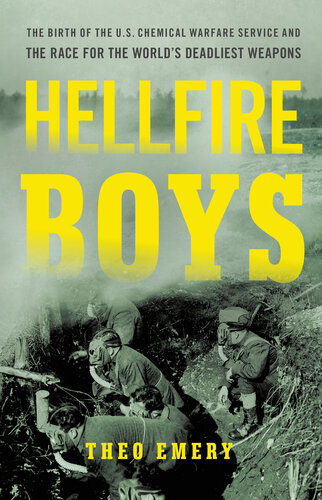
Hellfire Boys
The Birth of the U.S. Chemical Warfare Service and the Race for the World's Deadliest Weapons
کتاب های مرتبط
- اطلاعات
- نقد و بررسی
- دیدگاه کاربران
نقد و بررسی

October 1, 2017
An illumination of the "little understood and...poorly documented" story of a significant piece of the "history of chemical warfare in the United States."Following the declaration of war against Germany in 1917, America scrambled to expand its minuscule infantry, artillery, and air force. Furthermore, the country's poison gas infrastructure was nonexistent, so the government was forced to build a chemical warfare service from scratch. It's an obscure aspect of a distant war, so even military buffs will learn from this intensely researched, often unnerving account by journalist Emery. Who in the government knew about gas? The answer, leaders decided, was the Bureau of Mines, an agency responsible for mining safety, which included protection against toxic underground gases. Its energetic director mailed 25,000 letters to chemists, engineers, and industries asking for contributions to the war effort. In a gush of patriotism similar to events after 9/11, enthusiastic responses poured in. By the end of 1917, thousands of researchers across the nation were busily analyzing existing gases, inventing new ones, and designing gas masks as the Army trained specialized units to hurl these chemicals at the enemy. By the end of the war, the Chemical Warfare Service was a full-fledged Army department with 20,000 members who fired more than 1,000 tons of gas at the Germans; they were supported by a massive network of factories and training grounds whose poisoned landscapes and buried but still deadly chemicals are still with us. The author concludes that poison gas was more trouble than it was worth, but, like germ warfare, it continues to fascinate fringe groups and rogue nations. The cast of characters at the beginning of the book is much-appreciated.Readers will share Emery's lack of nostalgia for this half-forgotten weapon, but they will admire this satisfying combination of technical background, battlefield fireworks, biographies of colorful major figures, and personal anecdotes from individual soldiers.
COPYRIGHT(2017) Kirkus Reviews, ALL RIGHTS RESERVED.

Starred review from November 1, 2017
War is always brutal, and it became even more so on April 22, 1915, when Germany shelled the Belgian city of Ypres with chlorine gas. When the United States entered World War I, Van Manning, director of the Bureau of Mines, was ready. Soon chemical research and testing was being carried out on the grounds of American University in Washington, DC, coopted by the government for the duration of the war. (The intervention may have saved the fledgling institution from bankruptcy.) Journalist Emery explains how by war's end, U.S. "hellfire boys" had hunted down and turned a German saboteur-scientist to the other side and built, staffed, and operated two secret testing facilities. Meanwhile, the U.S. Army was fighting a subterranean war over who owned chemical weaponry in America. By the time World War I ended, U.S. gas production was hitting its stride; if there had been another year of combat, the German countryside could have suffered extensive lethal poisons. VERDICT Moving crisply between stateside turf wars and battlefront combat, this well-written and well-researched slice of history will appeal to virtually any history or war buff.--David Keymer, Cleveland
Copyright 2017 Library Journal, LLC Used with permission.

November 1, 2017
War is always brutal, and it became even more so on April 22, 1915, when Germany shelled the Belgian city of Ypres with chlorine gas. When the United States entered World War I, Van Manning, director of the Bureau of Mines, was ready. Soon chemical research and testing was being carried out on the grounds of American University in Washington, DC, coopted by the government for the duration of the war. (The intervention may have saved the fledgling institution from bankruptcy.) Journalist Emery explains how by war's end, U.S. "hellfire boys" had hunted down and turned a German saboteur-scientist to the other side and built, staffed, and operated two secret testing facilities. Meanwhile, the U.S. Army was fighting a subterranean war over who owned chemical weaponry in America. By the time World War I ended, U.S. gas production was hitting its stride; if there had been another year of combat, the German countryside could have suffered extensive lethal poisons. VERDICT Moving crisply between stateside turf wars and battlefront combat, this well-written and well-researched slice of history will appeal to virtually any history or war buff.--David Keymer, Cleveland
Copyright 2017 Library Journal, LLC Used with permission.

October 15, 2017
The current standoff with North Korea has revived the specter of nuclear warfare to a level not seen since the height of the Cold War. Journalist Emery offers a useful and absorbing reminder that, a century earlier, it was a different weapon of mass destruction that terrified both soldiers and civilians. In 1915, German forces launched the first widespread use of chlorine gas on the battlefield; since the technology was well understood, Allied forces quickly responded in kind. As graphically described by Emery, both the physical and psychological effects were devastating. By the time the U.S. entered the war in 1917, the government had developed a substantial chemical-weapons program under the auspices of the powerful, well-funded Chemical Warfare Service. Initially, the program was defensive in nature, but it quickly turned to churning out a variety of lethal offensive weapons. As Emery indicates, the program drew huge numbers of experts from the fields of chemistry, engineering, and law enforcement to maintain secrecy. This is a timely and often unsettling examination of a previously well-hidden government program.(Reprinted with permission of Booklist, copyright 2017, American Library Association.)

























دیدگاه کاربران